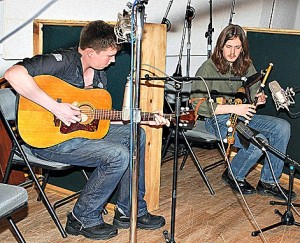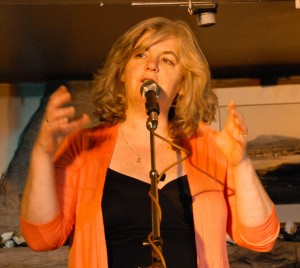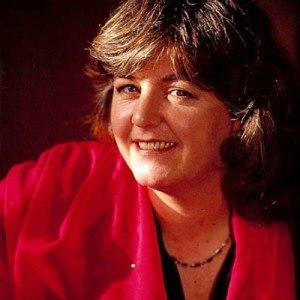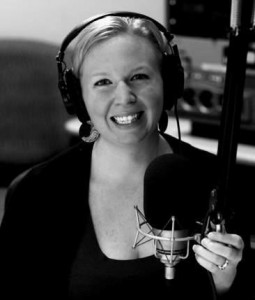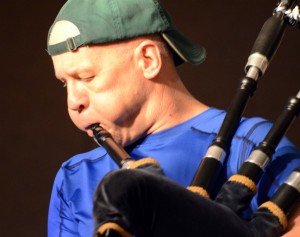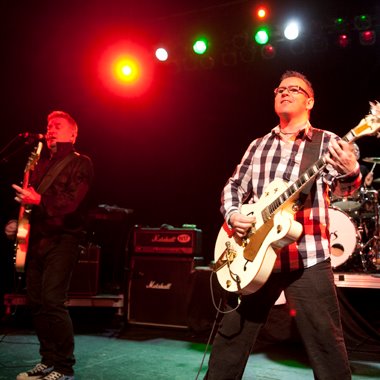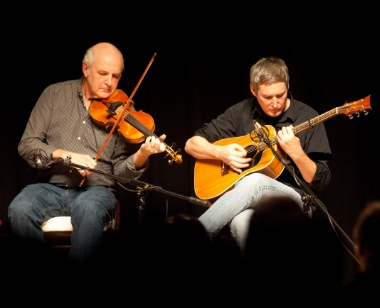
Randal Bays with Davey Mathias
Randal Bays coaxes the sounds of Clare and Galway from his fiddle as though he had been born there. But when he starts to speak, it’s with the remnants of a Midwest accent reshaped by years in the Pacific Northwest.
When Bays talks about back home, like the song, it’s Indiana.
Randal Bays will be in the Philly region next weekend for two shows: the first, on April 27, is a house concert in Lansdale with singer/guitarist Davey Mathias, then the two will do a concert on Saturday night at the Coatesville Cultural Center in Coatesville. He and Mathias are also offering free—thanks to Kildare’s of West Chester—workshops on Sunday at West Chester University, then playing the Kildare’s session from 7-9 PM. See our calendar for details.
I asked Bays if people hearing him for the first time are surprised that he’s not from Ireland. But Bays, who’s been part of the Irish music scene since the mid-1970s, says he doesn’t notice it any more.
“I used to play with [Derry-born guitarist and singer] Daithi Sproule a bit and after an intermission at one of our gigs, he was talking with this guy who said, ‘It’s great that after all these years in America you still have that Irish accent.” Daithi said, ‘Yeah.’ Then the guy says, ‘But your friend has completely lost his.’”
Bays laughs. He doesn’t hear that kind of thing much any more—and when he does, he considers it a compliment–because Irish trad aficionados know that Bays is the real deal—or “the genuine article,” as one music reviewer put it–no matter where he comes from. No matter that he’s not even Irish.
“The problem with me is that I ain’t got no ethnic,” he confesses, laughing. “My mother’s and father’s families have been here since the 1600s and both sides were Welsh. My mother’s family was transported convicts from Britain. Australia was the big penal colony but the reason it opened up was that we got uppity. The American colonies had been the dumping ground for convicts, part of Britain’s social engineering policies that got rid of all their undesirables. Then the undesirables decided to have their own country, by god.”
He jokingly says he sometimes thinks that he’d get more people at his shows if he made up a story—that he was born in “the misty mountains of Clare,” like his friend, fiddler Martin Hayes, with whom he’s performed on several CDs, including Hayes’ first, where Bays accompanied him on guitar.
“I lived in Seattle and had a friend who was Martin’s booking agent then, Helen, and Martin was a total unknown at the time,” Bays says, weaving yet another story in the Irish style. “He had a house concert and wanted a guitar player to play with him. All the real guitar players in Seattle couldn’t make it so she called me. She said, ‘You used to play guitar, didn’t you?’ Then she told me that Martin Hayes was [Tulla Ceili Band fiddler] P.J. Hayes’ son and as soon as I heard that I was on board. I met Martin, had an instantaneous connection—we related musically as well as personally—and when we sat down to play it was an easy fit.”
They knew all the same songs, songs Bays had learned over the years from the likes of friends Kevin Burke, James Keane, Daithi Sproule, and Micheal O’Domhnaill after his first introduction to Irish music—“on a dark and rainy night as it usually is in Portland”—at a session in a small pub. “It was full of smoke, there was beer everywhere, and people playing passionately, and I went crazy for it on the spot,” says Bays.
He’d been a professional musician since he was 14, playing country-western guitar on a doughnut commercial on a local radio station in Indiana. By then he’d traded in the trumpet he’d been studying since the age of eight. Bays went to music school, but left after two years to earn his living making music—all kinds of music, from rock to blues, to classical guitar—in the Northwest, after leaving Indiana behind at 20.
His meeting with Hayes led to two recordings, the eponymous “Martin Hayes” in 1992, and “Under the Moon,” in 1995, both on the Green Linnet label, on which Bays played guitar. (He’s also featured on “Masters of the Irish Guitar.” He even toured with Hayes, leading to yet another funny story, this one taking place in Ireland where Bays was on stage with Martin and P.J. Hayes.
“Everybody loved us, but when we came off the stage, this old man came up to us and said, ‘It’s the Hayes’s and Bays’s, bejaysus.”
But Bays’ heart wasn’t in guitar accompaniment. He wanted to play the fiddle, so he parted ways with his friend and concentrated on fiddling. You can hear the results of that on his critically acclaimed CDs, including “Katy Bar the Door,” “Oyster Light,” “The Salmon’s Leap,” and “Dig With It.”
He didn’t intentionally lean toward the Clare-Galway style. “You listen for what you care for,” he says, “you go toward the musicians you feel something from. When I first got going, I was meeting Clare and Galway fiddlers at every turn. People would go to sessions in Doolin and Miltown Malbay [home of the famed Willy Clancy music festival] and bring me back cassettes and I cut my teeth on that. I lived and breathed tapes I had of P.J. Hayes so when I met Martin it all synched up in that way.”
Bays lives the semi-nomadic life of a musician, performing at venues large and small across the country, and teaching, including at the Catskill’s Irish Arts Week, at Swannanoa in South Carolina, and, until recently, his own Friday Harbor Irish Music Week in Roche Harboro, Washington.
He met his current partner, Mathias, at Swannanoa. He had been part of a Celtic trad group called The Corner House with his wife, Andi Hearn, though Mathias is also part of a long-running punk rock band.
“Oh no, all the trad heads are going to be saying, ‘Punk rock? I’m staying home.’ But it’s the wild spirit he brings to trad too,” says Bays. “Davey’s pretty good, as long as he doesn’t break parole.” He laughs heartily. “”He’s an unusual guy who learned the music just by hearing it. He has a great ear as well as a great spirit.”
But Mathias—and Bays himself—don’t bring elements of their other musical influences to trad. Bays doesn’t like Celtic rock. “Daithi said a funny thing one time about Celtic fusion. He hates to say anything negative. But he said, ‘If people fuse two kinds of music they should be able to play at least one of them well.’”
Bays says that electrifying Irish traditional tunes isn’t something he wants to do. “What I’m looking for in music is power, but I just don’t believe in getting it through volume any more. It’s not a function of age. I’ve been that way since I was in my 20s.
“The power of Irish music,” Bays says, “is in one fiddle player sitting on a chair, all the harmony and beauty of those melodic lines. When it’s working, it’s a rare thing in music. Pop music played at high volume with a strong beat and bass functions differently. It’s meant to overwhelm you. That’s a good thing. You can’t converse, you can’t think, you’re overwhelmed by it and go with it. Irish traditional music requires listeners to be able and willing to reach out with their minds and hearts to meet it halfway. That’s what attracted me to it and what I still love about it.”

